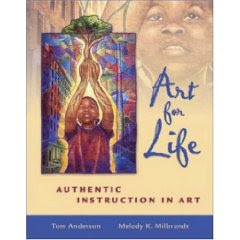Notes on "Souvenirs of Formalism: From Modernism to Postmodernism and Deconstruction"
Souvenirs of Formalism: From Modernism to Postmodernism and Deconstruction
Author(s): Bob Lloyd
Source: Art Education, Vol. 50, No. 3, Framing the Art Curriculum (May, 1997), pp. 15-22 Published by: National Art Education Association
Stable URL: http://www.jstor.org/stable/3193693
Accessed: 08/08/2009 15:01
Modernist perspective-"after you have learned the grammar, you will at least know what rules you are breaking if you do so."
Professor John A. Michael (1983) of Miami University describes the Bauhaus approach to art education as the Art for Art's Sake Approach, concluding that a teacher using this approach would be concerned with a knowledge of art and the quality of art produced
(the Bauhaus approach—radically simplified forms, the rationality and functionality, and the idea that mass-production was reconcilable with the individual artistic spirit. http://en.wikipedia.org/wiki/Bauhaus)
Mies van der Rohe (head of the Bauhaus School from 1930 until 1933): it is better to be good rather than original if you must choose a course or curriculum
The term modernism, as I am describing it, refers primarily to areas of applied design and problem solving, and is relevant to painting and furniture design
I would like to admit that today's postmodernism might be considered an intuitive rather than a rational approach, but what I see is capriciousness and novelty celebrating itself as personal power masquerading as direct knowledge.
“The Language of Vision”
A Notion of Order
Because chaos is repugnant and disturbing, the mind strives to discover meaningful relationships and to “see” things as a whole. Each shape and space should be a logical consequence of another, and all should be related to the intent of the particular design, according to the modernist conception of good design
Clarity of Form and Space
A unity or formal continuum should be maintained, as should a spatial continuum.
Significant Contrast
An expression of significant contrast would be the idea of unity and contrast, unity and variety, or variations of a theme. A designer attempts to intensify the visual experience by using contrast in such a manner.
Postmodernism has given us permission to do "our own thing." It has suggested that there is no wrong in art
University professors complain that a student will argue that his/her judgment is as valid as the professor's and, if that is problematic, then it's the professor’s problem
And what has rebellion against the "grammar of design" produced? Student artists' unbridled desires to be novel and noteworthy lack cognizance of established principles being violated
The Bauhaus, once arbiter of 20th century aesthetic morality (form follows function) and culmination of 19th century morality (beauty is truth, truth is beauty), seemed not only forgotten, but trampled underfoot.
One of the consequences of the emphasis on attention-getting devices was that less and less care was being given to aesthetic matters. It's not just a question of rejecting the Bauhaus school but of fine tuning
I would argue that students need to be given problems which are sufficiently challenging to sustain interest, but that copying should be discouraged
Postmodernism, unfortunately, does not consider originality a priority
Modernism gave us a language of vision and a grammar of design with an essential life of its own based upon things intelligible in themselves, that is, guiding principles without which we have very little sense of direction.
Postmodernism has rejected such principles in favor of doing one's own thing, which has produced small, localized, non-theoretical "narratives."
Thus, I strongly argue for foundation courses in the elements of art, the language of vision, and the grammar of design. And, for a teacher whose role is to guide, constructive criticism will play a very important role
Subscribe to:
Post Comments (Atom)






I agree that postmodern art presents a dilemma. Sometimes, I think that it can promote a kind of aesthetic anarchy. But in my website, in my postmodern art page, I refer instead to aesthetic revolution: http://contemporary-art-dialogue.com/postmodern-art.html
ReplyDeleteHowdy - Not sure if the last few paragraphs are your ideas or the authors...I wonder if there is a way to make that clearer on the blog so I know who I'm agreeing/disagreeing with. :-D
ReplyDeleteThe ideas are the authors. I'll try to be more clear in the future.
ReplyDelete